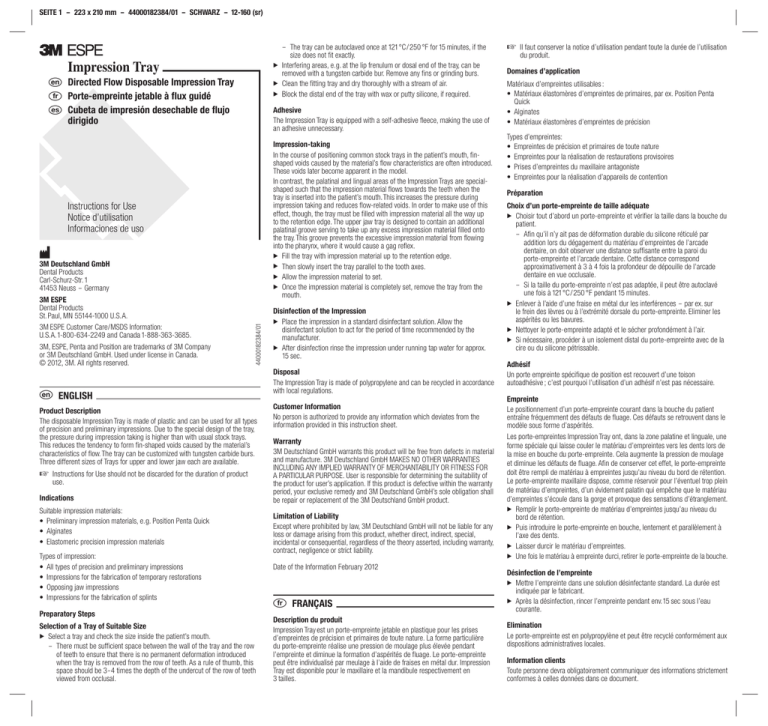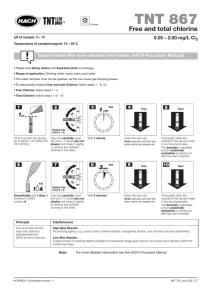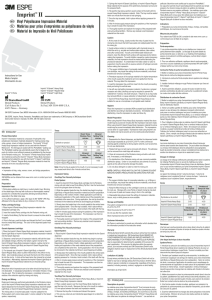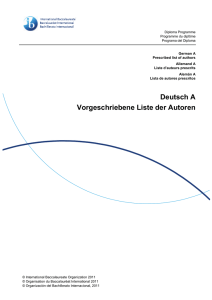Impression Tray
Anuncio

SEITE 1 - 223 x 210 mm - 44000182384/01 - SCHWARZ - 12-160 (sr) fr es en Impression Tray 왘 Directed Flow Disposable Impression Tray Porte-empreinte jetable à flux guidé Cubeta de impresión desechable de flujo dirigido 왘 왘 Adhesive The Impression Tray is equipped with a self-adhesive fleece, making the use of an adhesive unnecessary. Impression-taking In the course of positioning common stock trays in the patient’s mouth, finshaped voids caused by the material’s flow characteristics are often introduced. These voids later become apparent in the model. In contrast, the palatinal and lingual areas of the Impression Trays are specialshaped such that the impression material flows towards the teeth when the tray is inserted into the patient’s mouth.This increases the pressure during impression taking and reduces flow-related voids. In order to make use of this effect, though, the tray must be filled with impression material all the way up to the retention edge. The upper jaw tray is designed to contain an additional palatinal groove serving to take up any excess impression material filled onto the tray. This groove prevents the excessive impression material from flowing into the pharynx, where it would cause a gag reflex. 왘 Fill the tray with impression material up to the retention edge. 왘 Then slowly insert the tray parallel to the tooth axes. 왘 Allow the impression material to set. 왘 Once the impression material is completely set, remove the tray from the mouth. en 44000182384/01 Instructions for Use Notice d’utilisation Informaciones de uso 3M Deutschland GmbH Dental Products Carl-Schurz-Str. 1 41453 Neuss - Germany 3M ESPE Dental Products St. Paul, MN 55144-1000 U.S.A. 3M ESPE Customer Care/MSDS Information: U.S.A.1-800-634-2249 and Canada 1-888-363-3685. 3M, ESPE, Penta and Position are trademarks of 3M Company or 3M Deutschland GmbH. Used under license in Canada. © 2012, 3M. All rights reserved. ENGLISH Product Description The disposable Impression Tray is made of plastic and can be used for all types of precision and preliminary impressions. Due to the special design of the tray, the pressure during impression taking is higher than with usual stock trays. This reduces the tendency to form fin-shaped voids caused by the material’s characteristics of flow. The tray can be customized with tungsten carbide burs. Three different sizes of Trays for upper and lower jaw each are available. Instructions for Use should not be discarded for the duration of product use. Indications Suitable impression materials: • Preliminary impression materials, e.g. Position Penta Quick • Alginates • Elastomeric precision impression materials Types of impression: • All types of precision and preliminary impressions • Impressions for the fabrication of temporary restorations • Opposing jaw impressions • Impressions for the fabrication of splints Preparatory Steps Selection of a Tray of Suitable Size Select a tray and check the size inside the patient’s mouth. - There must be sufficient space between the wall of the tray and the row of teeth to ensure that there is no permanent deformation introduced when the tray is removed from the row of teeth. As a rule of thumb, this space should be 3-4 times the depth of the undercut of the row of teeth viewed from occlusal. 왘 - The tray can be autoclaved once at 121°C/250 °F for 15 minutes, if the size does not fit exactly. Interfering areas, e.g. at the lip frenulum or dosal end of the tray, can be removed with a tungsten carbide bur. Remove any fins or grinding burs. Clean the fitting tray and dry thoroughly with a stream of air. Block the distal end of the tray with wax or putty silicone, if required. Disinfection of the Impression 왘 Place the impression in a standard disinfectant solution. Allow the disinfectant solution to act for the period of time recommended by the manufacturer. 왘 After disinfection rinse the impression under running tap water for approx. 15 sec. Disposal The Impression Tray is made of polypropylene and can be recycled in accordance with local regulations. Customer Information No person is authorized to provide any information which deviates from the information provided in this instruction sheet. Warranty 3M Deutschland GmbH warrants this product will be free from defects in material and manufacture. 3M Deutschland GmbH MAKES NO OTHER WARRANTIES INCLUDING ANY IMPLIED WARRANTY OF MERCHANTABILITY OR FITNESS FOR A PARTICULAR PURPOSE. User is responsible for determining the suitability of the product for user’s application. If this product is defective within the warranty period, your exclusive remedy and 3M Deutschland GmbH’s sole obligation shall be repair or replacement of the 3M Deutschland GmbH product. Limitation of Liability Except where prohibited by law, 3M Deutschland GmbH will not be liable for any loss or damage arising from this product, whether direct, indirect, special, incidental or consequential, regardless of the theory asserted, including warranty, contract, negligence or strict liability. Date of the Information February 2012 fr FRANÇAIS Description du produit Impression Tray est un porte-empreinte jetable en plastique pour les prises d’empreintes de précision et primaires de toute nature. La forme particulière du porte-empreinte réalise une pression de moulage plus élevée pendant l’empreinte et diminue la formation d’aspérités de fluage. Le porte-empreinte peut être individualisé par meulage à l’aide de fraises en métal dur. Impression Tray est disponible pour le maxillaire et la mandibule respectivement en 3 tailles. Il faut conserver la notice d’utilisation pendant toute la durée de l’utilisation du produit. Domaines d’application Matériaux d’empreintes utilisables : • Matériaux élastomères d’empreintes de primaires, par ex. Position Penta Quick • Alginates • Matériaux élastomères d’empreintes de précision Types d’empreintes: • Empreintes de précision et primaires de toute nature • Empreintes pour la réalisation de restaurations provisoires • Prises d’empreintes du maxillaire antagoniste • Empreintes pour la réalisation d’appareils de contention Préparation Choix d’un porte-empreinte de taille adéquate Choisir tout d’abord un porte-empreinte et vérifier la taille dans la bouche du patient. - Afin qu’il n’y ait pas de déformation durable du silicone réticulé par addition lors du dégagement du matériau d’empreintes de l’arcade dentaire, on doit observer une distance suffisante entre la paroi du porte-empreinte et l’arcade dentaire. Cette distance correspond approximativement à 3 à 4 fois la profondeur de dépouille de l’arcade dentaire en vue occlusale. - Si la taille du porte-empreinte n’est pas adaptée, il peut être autoclavé une fois à 121°C/250 °F pendant 15 minutes. 왘 Enlever à l’aide d’une fraise en métal dur les interférences - par ex. sur le frein des lèvres ou à l’extrémité dorsale du porte-empreinte. Eliminer les aspérités ou les bavures. 왘 Nettoyer le porte-empreinte adapté et le sécher profondément à l’air. 왘 Si nécessaire, procéder à un isolement distal du porte-empreinte avec de la cire ou du silicone pétrissable. 왘 Adhésif Un porte empreinte spécifique de position est recouvert d’une toison autoadhésive ; c’est pourquoi l’utilisation d’un adhésif n’est pas nécessaire. Empreinte Le positionnement d’un porte-empreinte courant dans la bouche du patient entraîne fréquemment des défauts de fluage. Ces défauts se retrouvent dans le modèle sous forme d’aspérités. Les porte-empreintes Impression Tray ont, dans la zone palatine et linguale, une forme spéciale qui laisse couler le matériau d’empreintes vers les dents lors de la mise en bouche du porte-empreinte. Cela augmente la pression de moulage et diminue les défauts de fluage. Afin de conserver cet effet, le porte-empreinte doit être rempli de matériau à empreintes jusqu’au niveau du bord de rétention. Le porte-empreinte maxillaire dispose, comme réservoir pour l’éventuel trop plein de matériau d’empreintes, d’un évidement palatin qui empêche que le matériau d’empreintes s’écoule dans la gorge et provoque des sensations d’étranglement. 왘 Remplir le porte-empreinte de matériau d’empreintes jusqu’au niveau du bord de rétention. 왘 Puis introduire le porte-empreinte en bouche, lentement et parallèlement à l’axe des dents. 왘 Laisser durcir le matériau d’empreintes. 왘 Une fois le matériau à empreinte durci, retirer le porte-empreinte de la bouche. Désinfection de l’empreinte 왘 Mettre l’empreinte dans une solution désinfectante standard. La durée est indiquée par le fabricant. 왘 Après la désinfection, rincer l’empreinte pendant env.15 sec sous l’eau courante. Elimination Le porte-empreinte est en polypropylène et peut être recyclé conformément aux dispositions administratives locales. Information clients Toute personne devra obligatoirement communiquer des informations strictement conformes à celles données dans ce document. SEITE 2 - 223 x 210 mm - 44000182384/01 - SCHWARZ - 12-160 (sr) Garantie 3M Deutschland GmbH garantit que ce produit est dépourvu de défauts matériels et de fabrication. 3M Deutschland GmbH NE FOURNIT AUCUNE AUTRE GARANTIE, NI AUCUNE GARANTIE IMPLICITE OU DE QUALITE MARCHANDE OU DE D’ADEQUATION A UN EMPLOI PARTICULIER. L’utilisateur est responsable de la détermination de l’adéquation du produit à son utilisation. Si ce produit présente un défaut durant sa période de garantie, votre seul recours et l’unique obligation de 3M Deutschland GmbH sera la réparation ou le remplacement du produit 3M Deutschland GmbH. Limitation de responsabilité A l’exception des lieux où la loi l’interdit, 3M Deutschland GmbH ne sera tenu responsable d’aucune perte ou dommage découlant de ce produit, qu’ils soient directs, indirects, spécifiques, accidentels ou consécutifs, quels que soient les arguments avancés, y compris la garantie, le contrat, la négligence ou la stricte responsabilité. Mise à jour de l’information : Février 2012 es ESPAÑOL Descripción del producto Impression Tray desechable es una cubeta de impresión desechable de plástico para impresiones de precisión y anatómicas de todo tipo. El diseño especial de la cubeta genera una mayor presión de sellado durante la impresión y reduce la formación de talones de fluencia condicionados por la corriente. La cubeta puede esmerilarse para la individualización con fresas de metal duro. Impression Tray es suministrable para el maxilar superior e inferior en 3 tamaños respectivamente. Las informaciones de uso deben conservarse durante todo el tiempo de uso de este producto. Campos de aplicación Materiales de impresión utilizables: • Materiales elastómeros de impresión de anatómica, p.ej. Position Penta Quick • Alginatos • Materiales elastómeros de impresión de precisión Tipo de la impresión: • Impresiones de precisión y anatómicas de todo tipo • Impresiones para la fabricación de provisorios • Impresiones del maxilar opuesto • Impresiones para la fabricación de férulas Preparativos Prueba 왘 En primer lugar seleccionar una cubeta y controlar el tamaño de la boca del paciente. - A fin de que al soltar la masa de impresión de la fila de dientes no se llegue a dar una deformación permanente del material de impresión, tiene que haber una separación suficiente entre la pared de la cubeta y la fila de dientes. Una regla práctica para esta separación es 3 a 4 veces la profundidad del socavado de la fila de dientes, visto desde oclusal. - Si la cubeta no cupiese, puede autoclavarse una vez a 121°C/250 °F durante 15 minutos. 왘 Eliminar las zonas que estorben - p. ej. en los labios o extremo dorsal de la cubeta - con una fresa de metal duro. Eliminar los talones o virutas de esmerilado. 왘 Limpiar la cubeta adaptada y secar abundantemente con aire. 왘 Si es necesario, retener la cubeta con cera o silicona maleable distalmente. Adhesivo Impression Tray está equipado con un vellón autorretentivo, por lo que no es necesario el uso de un adhesivo. Impresión Al posicionar una cubeta de confección habitual en el comercio en la boca del paciente, a menudo resultan fallos condicionados por la corriente. Estos fallos aparecen más tarde en el modelo como talones de fluidez. Las cubetas de impresión Impression Tray tienen en la zona palatinal y también lingual una forma especial, que deja fluir el material de impresión en sentido de los dientes al meter la cubeta en la boca. Con ello aumenta la presión de sellado y se evitan fallos condicionados por la corriente. Para obtener este efecto, la cubeta tiene que llenarse hasta debajo del borde de retención con material de impresión. Como reserva para un posible material llenado en demasía la cubeta para el maxilar superior dispone de un rebaje palatinal, que evita que el material de impresión fluya hacia la garganta y provoque una irritación de ahogo. 왘 Llenar la cubeta con material de impresión hasta debajo del borde de retención. 왘 A continuación meter la cubeta en la boca lentamente y de forma paralela al eje de dientes. 왘 Dejar endurecerse el material de impresión. 왘 Después de que el material de impresión se ha endurecido, sacar la cubeta de la boca. Desinfección de la impresión 왘 Meter la impresión en una solución estándar de desinfección. La duración se rige según los datos del fabricante. 왘 Después de la desinfección aclarar la impresión aprox.15 seg. bajo agua corriente. Eliminación La cubeta de impresión Impression Tray está fabricada de polipropileno y puede reciclarse de acuerdo con las normas oficiales locales. Información para clientes Ninguna persona está autorizada a facilitar ninguna información que difiera en algún modo de la información suministrada en esta hoja de instrucciones. Garantía 3M Deutschland GmbH garantiza este producto contra defectos de los materiales y de fabricación. 3M Deutschland GmbH NO OTORGARÁ NINGUNA OTRA GARANTÍA, INCLUYENDO CUALQUIER GARANTÍA IMPLÍCITA, DE COMERCIABILIDAD O DE ADECUACIÓN A FINES PARTICULARES. El usuario es responsable de determinar la idoneidad del producto para la aplicación que desee darle. Si, dentro del periodo de garantía, se encuentra que este producto es defectuoso, la única obligación de 3M Deutschland GmbH y la única compensación que recibirá el cliente será la reparación o la sustitución del producto de 3M Deutschland GmbH. Limitación de responsabilidad Salvo en lo dispuesto por la Ley, 3M Deutschland GmbH no será responsable de ninguna pérdida o daño producido por este producto, ya sea directo, indirecto, especial, accidental o consecuente, independientemente del argumento presentado, incluyendo los de garantía, contrato, negligencia o responsabilidad estricta. Estado de información: Febrero 2012


